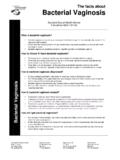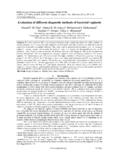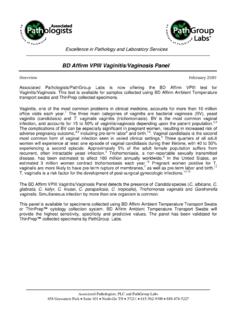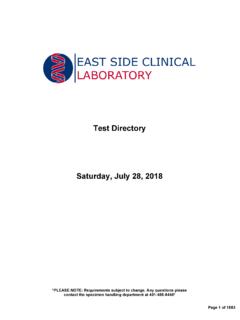Transcription of Bacterial vaginosis: a review on clinical trials with ...
1 NEwMICRoBIoLogICA, 36, 229-238, 2013 Bacterial vaginosis : a review on clinical trials with probioticsPaola Mastromarino1, Beatrice Vitali2, Luciana Mosca31 Department of Public Health and Infectious Diseases, Section of Microbiology, Roma, Italy;2 Department of Pharmacy and Biotechnology, University of Bologna, Bologna, Italy;3 Department of Biochemical Sciences, Sapienza University School of Medicine, Roma, ItalyINTRODUCTIONThe female lower genital tract, consisting of vagi-na and ectocervix, is an ecological niche whereseveral aerobe and anaerobe microorganisms co-exist in a dynamic balance.
2 The homeostasis ofthe vaginal ecosystem results from complex in-teractions and synergies among the host and dif-ferent microorganisms that colonize the vaginalmucosa (M rdh, 1991; Sobel, 1997). This ecosys-tem is dynamic with changes in structure andcomposition being influenced by age, menarche,time in menstrual cycle, pregnancy, infections,methods of birth control, sexual activity, use ofCorresponding authorPaola MastromarinoDepartment of Public Health and Infectious DiseasesSection of MicrobiologyUniversit Sapienza Piazzale Aldo Moro, 5 - 00185 Roma, ItalyE-mail: and hygiene (Srinivasan andFredricks, 2008).
3 In fertile, premenopausal healthywomen, the vaginal ecosystem is dominated byLactobacillusspp., but a diverse array of other bac-teria can be present in much lower numbers. , L. iners, L. jenseniiand L. gasseriare thepredominant vaginal Lactobacillusspecies(Lamont et al.,2011). The main frequent unde-sirable organisms are yeasts (Candida albicans,Candida tropicalis, Candida krusei), anaerobic bac-teria responsible for vaginosis (Gardnerella vagi-nalis, Mycoplasma hominis,Atopobium vaginae,Prevotellaspp., Veillonellaspp., Mobiluncusspp.),uropathogens (Escherichia coli, Proteusspp.)
4 ,Klebsiellaspp., Serratiaspp.), and sexually trans-mitted viruses (HIV, Herpes virus) (Lamont et al.,2011). Lactobacilli are involved in maintaining thenormal vaginal microflora by preventing over-growth of pathogenic and opportunistic organ-isms (R nnqvist et al., 2006). The principal mech-anisms by which lactobacilli exert their protectivefunctions are: Bacterial vaginosis (BV) is the most common vaginal syndrome afflicting fertile, premenopausal and pregnant is associated with important adverse health conditions and infectious complications.
5 Therapy with oral or localrecommended antibiotics is often associated with failure and high rates of recurrences. The dominance of lactobacilliin healthy vaginal microbiota and its depletion in BV has given rise to the concept of oral or vaginal use of probioticLactobacillusstrains for treatment and prevention of BV. This review investigated the evidence for the use of a singlestrain or cocktail of probiotics, administered orally or intravaginally, either alone or in conjunction with antibioticsfor the treatment of BV. Lactobacilli use in BV is supported by positive results obtained in some clinical trials .
6 Themajority of clinical trials yielding positive results have been performed using probiotic preparations containing highdoses of lactobacilli suggesting that, beside strain characteristics, the amount of exogenously applied lactobacilli couldhave a role in the effectiveness of the , substantial heterogeneity in products, trial methodologies andoutcome measures do not provide sufficient evidence for or against recommending probiotics for the treatment of WORDS: Bacterial vaginosis , Probiotics, Lactobacilli, Controlled clinical May 12, 2013 Accepted May 28, 20131.
7 Stimulation of the immune system;2. competition with other microorganisms fornutrients and for adherence to the vaginal ep-ithelium;3. reduction of the vaginal pH by the productionof organic acids, especially lactic acid;4. production of antimicrobial substances, suchas bacteriocins, and hydrogen peroxide(Aroutcheva et al., 2001).The hydrogen peroxide microbial metabolite rep-resents one of the most effective protective agentsagainst pathogens. It has been observed that 70%to 95% of lactobacilli present in the vaginal floraof healthy women produce hydrogen percentage drops to 5% in women affectedby vaginal infections (Eschenbach et al.)
8 , 1989). Bacterial VAGINOSISB acterial vaginosis (BV) represents the most com-mon vaginal syndrome afflicting fertile, pre-menopausal and pregnant women, with an inci-dence rate ranging from 5% to 50% (Sobel, 1997).BV is a complex, polymicrobial disorder charac-terized by an overgrowth of strict or facultativeanaerobic bacteria (Gardnerella vaginalis,Atopobium vaginae, Prevotellaspp., Mobiluncusspp., Mycoplasma hominis) and a reduction oflactobacilli particularly those producing hydro-gen peroxide (Fredricks et al., 2005; Lamont etal., 2011).
9 Women with BV typically complain ofvaginal discomfort and homogeneous malodor-ous vaginal discharge, which is more noticeableafter unprotected intercourse, although a sub-stantial fraction of women are asymptomatic(Klebanoff et al., 2004). The overgrowth of vagi-nal anaerobes determines an increased produc-tion of amines (putrescine, cadaverine andtrimethylamine) that become volatile at alkalinepH, after sexual intercourse and during themenstrual cycle, and contribute to the typicalmalodor of the vaginal discharge (Chen et al.,1979).
10 BV is frequently disregarded since thesymptoms are often insignificant, however theclinical consequences could be important. In fact,the alterations in the vaginal microbiota havebeen associated with ascending infections andobstetric complications (Koumans et al., 2002),as well as with urinary tract infections (Harmanliet al., 2000). In women undergoing in vitrofertil-ization, BV may result in lower implantation ratesand increased rates of early pregnancy loss(Eckert et al., 2003; Verstraelen et al., 2005).Increasing data also indicate that BV facilitatesthe acquisition of sexually transmitted diseasessuch as Neisseria gonorrhoeae, Chlamydia tra-chomatis, HIV and Herpes simplex virus type-2infection (HSV-2) (Martin et al.)







